Product Failure Modes and Effects Analysis of Vehicle Light Bulbs
VerifiedAdded on 2023/06/15
|8
|1830
|114
AI Summary
This report analyzes the failure modes and effects of vehicle light bulbs and suggests strategies for improvement. It includes a quality function deployment matrix and recommendations for future work.
Contribute Materials
Your contribution can guide someone’s learning journey. Share your
documents today.

2/9/2018
Student Name
product failure modes and effects analysis -Bulb
Student Name
product failure modes and effects analysis -Bulb
Secure Best Marks with AI Grader
Need help grading? Try our AI Grader for instant feedback on your assignments.
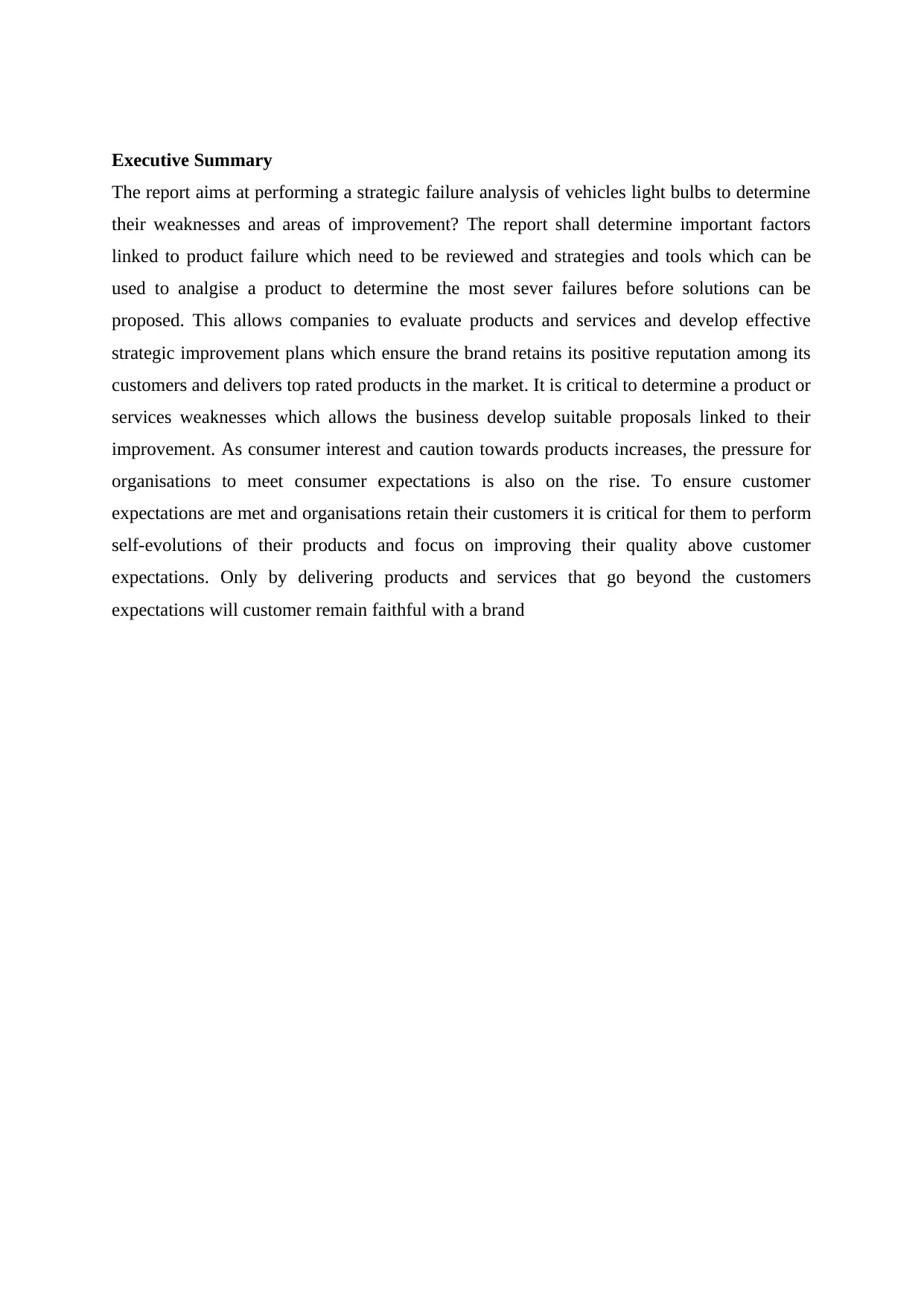
Executive Summary
The report aims at performing a strategic failure analysis of vehicles light bulbs to determine
their weaknesses and areas of improvement? The report shall determine important factors
linked to product failure which need to be reviewed and strategies and tools which can be
used to analgise a product to determine the most sever failures before solutions can be
proposed. This allows companies to evaluate products and services and develop effective
strategic improvement plans which ensure the brand retains its positive reputation among its
customers and delivers top rated products in the market. It is critical to determine a product or
services weaknesses which allows the business develop suitable proposals linked to their
improvement. As consumer interest and caution towards products increases, the pressure for
organisations to meet consumer expectations is also on the rise. To ensure customer
expectations are met and organisations retain their customers it is critical for them to perform
self-evolutions of their products and focus on improving their quality above customer
expectations. Only by delivering products and services that go beyond the customers
expectations will customer remain faithful with a brand
The report aims at performing a strategic failure analysis of vehicles light bulbs to determine
their weaknesses and areas of improvement? The report shall determine important factors
linked to product failure which need to be reviewed and strategies and tools which can be
used to analgise a product to determine the most sever failures before solutions can be
proposed. This allows companies to evaluate products and services and develop effective
strategic improvement plans which ensure the brand retains its positive reputation among its
customers and delivers top rated products in the market. It is critical to determine a product or
services weaknesses which allows the business develop suitable proposals linked to their
improvement. As consumer interest and caution towards products increases, the pressure for
organisations to meet consumer expectations is also on the rise. To ensure customer
expectations are met and organisations retain their customers it is critical for them to perform
self-evolutions of their products and focus on improving their quality above customer
expectations. Only by delivering products and services that go beyond the customers
expectations will customer remain faithful with a brand
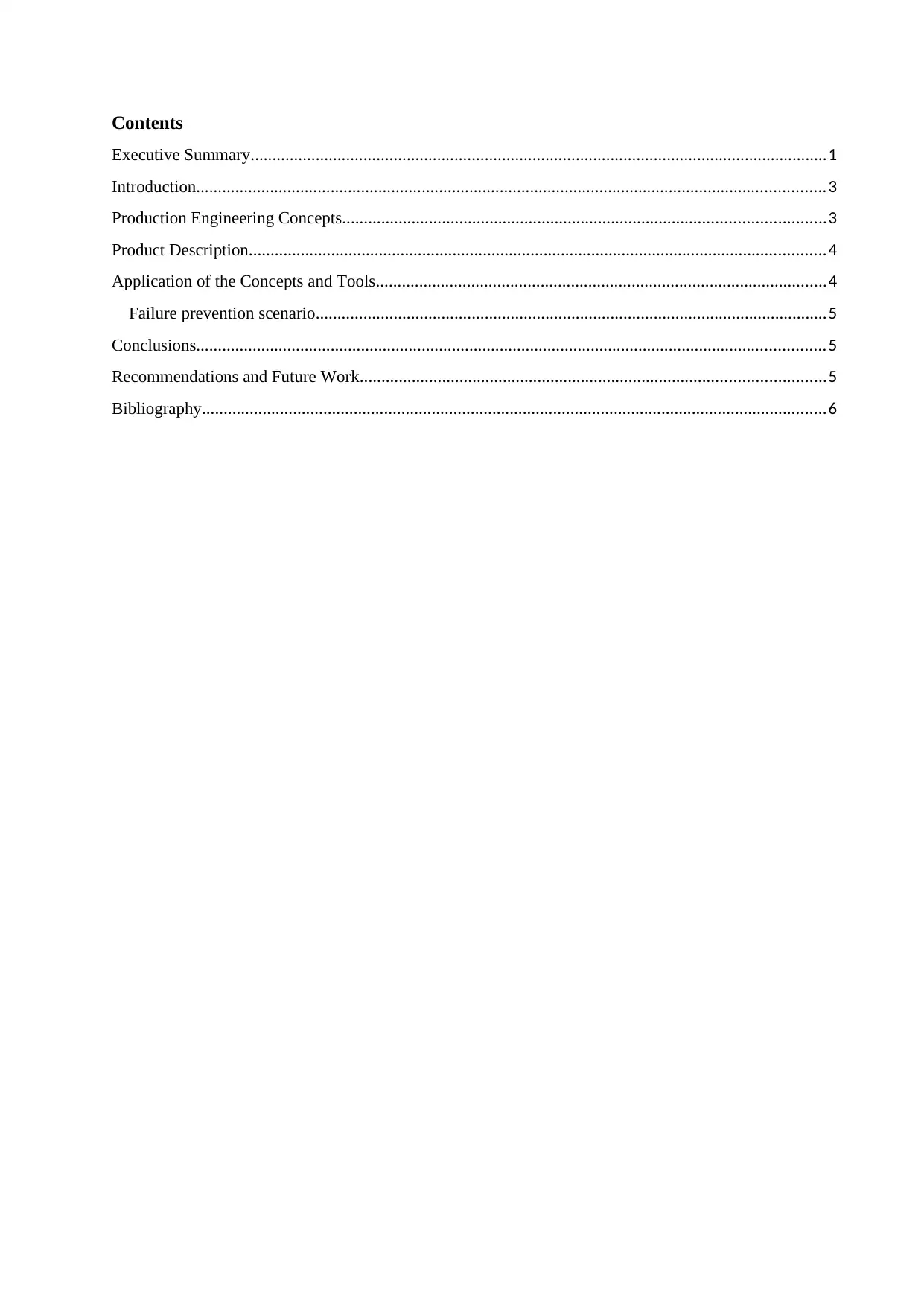
Contents
Executive Summary.....................................................................................................................................1
Introduction.................................................................................................................................................3
Production Engineering Concepts...............................................................................................................3
Product Description.....................................................................................................................................4
Application of the Concepts and Tools........................................................................................................4
Failure prevention scenario......................................................................................................................5
Conclusions.................................................................................................................................................5
Recommendations and Future Work...........................................................................................................5
Bibliography................................................................................................................................................6
Executive Summary.....................................................................................................................................1
Introduction.................................................................................................................................................3
Production Engineering Concepts...............................................................................................................3
Product Description.....................................................................................................................................4
Application of the Concepts and Tools........................................................................................................4
Failure prevention scenario......................................................................................................................5
Conclusions.................................................................................................................................................5
Recommendations and Future Work...........................................................................................................5
Bibliography................................................................................................................................................6
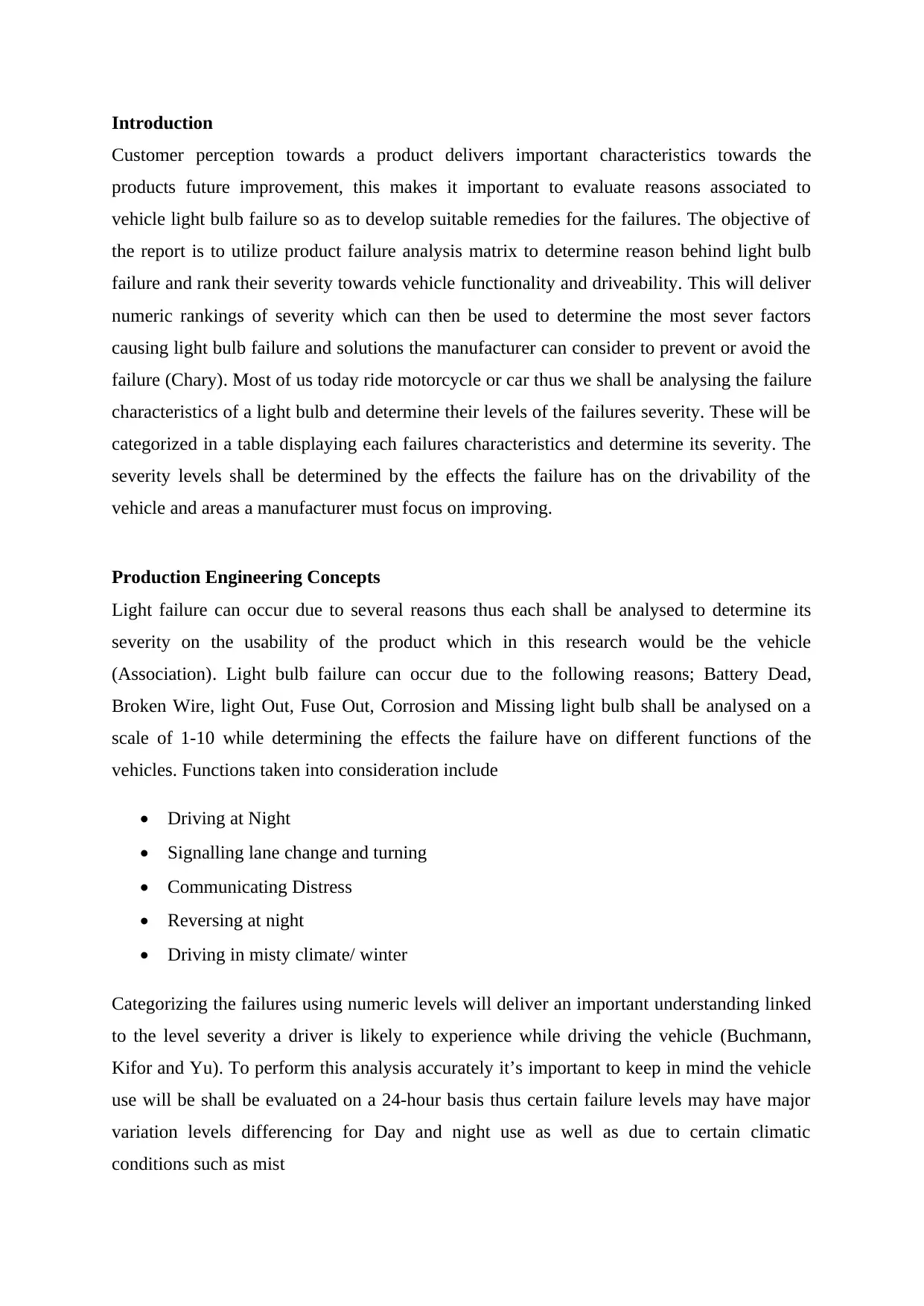
Introduction
Customer perception towards a product delivers important characteristics towards the
products future improvement, this makes it important to evaluate reasons associated to
vehicle light bulb failure so as to develop suitable remedies for the failures. The objective of
the report is to utilize product failure analysis matrix to determine reason behind light bulb
failure and rank their severity towards vehicle functionality and driveability. This will deliver
numeric rankings of severity which can then be used to determine the most sever factors
causing light bulb failure and solutions the manufacturer can consider to prevent or avoid the
failure (Chary). Most of us today ride motorcycle or car thus we shall be analysing the failure
characteristics of a light bulb and determine their levels of the failures severity. These will be
categorized in a table displaying each failures characteristics and determine its severity. The
severity levels shall be determined by the effects the failure has on the drivability of the
vehicle and areas a manufacturer must focus on improving.
Production Engineering Concepts
Light failure can occur due to several reasons thus each shall be analysed to determine its
severity on the usability of the product which in this research would be the vehicle
(Association). Light bulb failure can occur due to the following reasons; Battery Dead,
Broken Wire, light Out, Fuse Out, Corrosion and Missing light bulb shall be analysed on a
scale of 1-10 while determining the effects the failure have on different functions of the
vehicles. Functions taken into consideration include
• Driving at Night
• Signalling lane change and turning
• Communicating Distress
• Reversing at night
• Driving in misty climate/ winter
Categorizing the failures using numeric levels will deliver an important understanding linked
to the level severity a driver is likely to experience while driving the vehicle (Buchmann,
Kifor and Yu). To perform this analysis accurately it’s important to keep in mind the vehicle
use will be shall be evaluated on a 24-hour basis thus certain failure levels may have major
variation levels differencing for Day and night use as well as due to certain climatic
conditions such as mist
Customer perception towards a product delivers important characteristics towards the
products future improvement, this makes it important to evaluate reasons associated to
vehicle light bulb failure so as to develop suitable remedies for the failures. The objective of
the report is to utilize product failure analysis matrix to determine reason behind light bulb
failure and rank their severity towards vehicle functionality and driveability. This will deliver
numeric rankings of severity which can then be used to determine the most sever factors
causing light bulb failure and solutions the manufacturer can consider to prevent or avoid the
failure (Chary). Most of us today ride motorcycle or car thus we shall be analysing the failure
characteristics of a light bulb and determine their levels of the failures severity. These will be
categorized in a table displaying each failures characteristics and determine its severity. The
severity levels shall be determined by the effects the failure has on the drivability of the
vehicle and areas a manufacturer must focus on improving.
Production Engineering Concepts
Light failure can occur due to several reasons thus each shall be analysed to determine its
severity on the usability of the product which in this research would be the vehicle
(Association). Light bulb failure can occur due to the following reasons; Battery Dead,
Broken Wire, light Out, Fuse Out, Corrosion and Missing light bulb shall be analysed on a
scale of 1-10 while determining the effects the failure have on different functions of the
vehicles. Functions taken into consideration include
• Driving at Night
• Signalling lane change and turning
• Communicating Distress
• Reversing at night
• Driving in misty climate/ winter
Categorizing the failures using numeric levels will deliver an important understanding linked
to the level severity a driver is likely to experience while driving the vehicle (Buchmann,
Kifor and Yu). To perform this analysis accurately it’s important to keep in mind the vehicle
use will be shall be evaluated on a 24-hour basis thus certain failure levels may have major
variation levels differencing for Day and night use as well as due to certain climatic
conditions such as mist
Secure Best Marks with AI Grader
Need help grading? Try our AI Grader for instant feedback on your assignments.
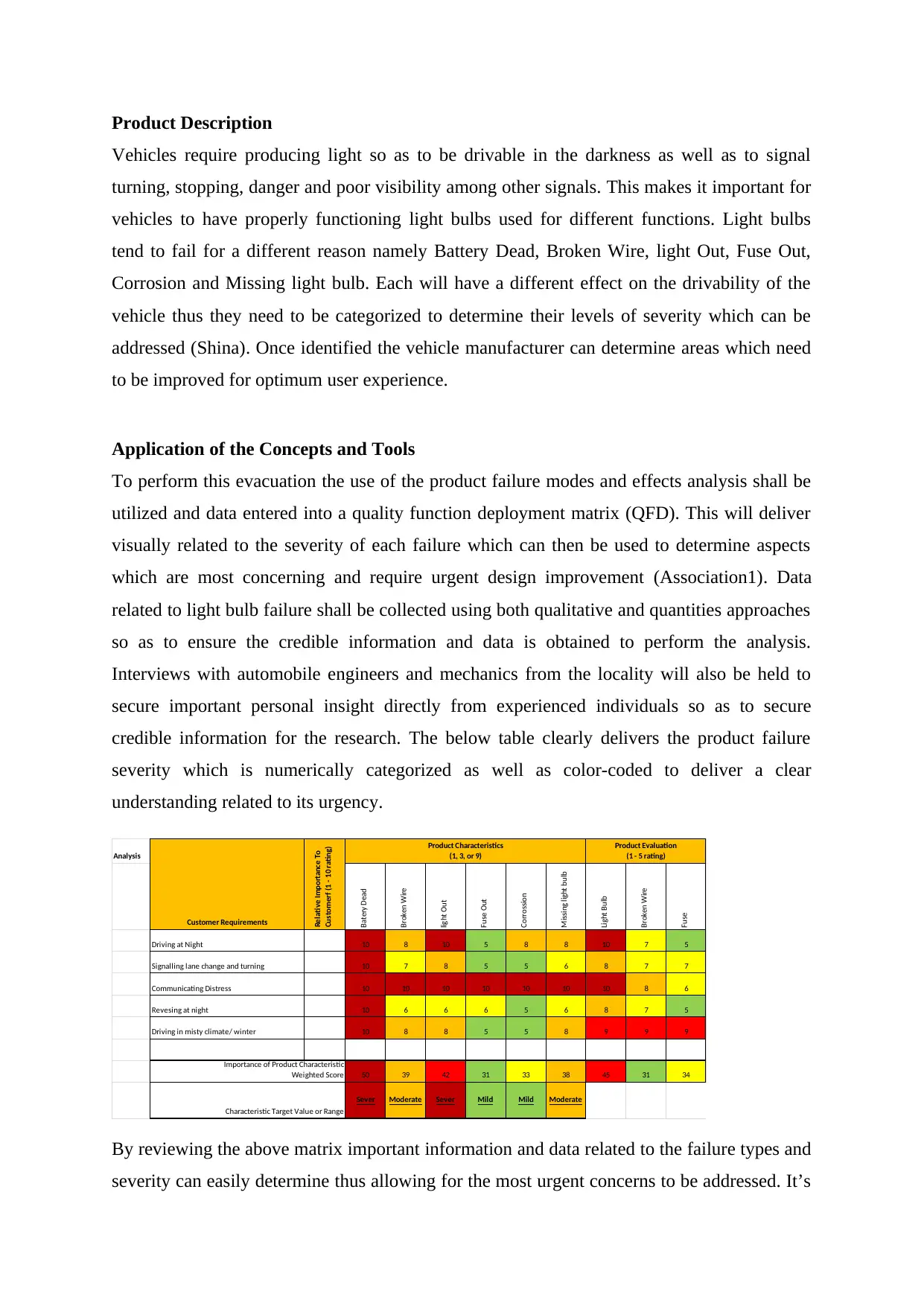
Product Description
Vehicles require producing light so as to be drivable in the darkness as well as to signal
turning, stopping, danger and poor visibility among other signals. This makes it important for
vehicles to have properly functioning light bulbs used for different functions. Light bulbs
tend to fail for a different reason namely Battery Dead, Broken Wire, light Out, Fuse Out,
Corrosion and Missing light bulb. Each will have a different effect on the drivability of the
vehicle thus they need to be categorized to determine their levels of severity which can be
addressed (Shina). Once identified the vehicle manufacturer can determine areas which need
to be improved for optimum user experience.
Application of the Concepts and Tools
To perform this evacuation the use of the product failure modes and effects analysis shall be
utilized and data entered into a quality function deployment matrix (QFD). This will deliver
visually related to the severity of each failure which can then be used to determine aspects
which are most concerning and require urgent design improvement (Association1). Data
related to light bulb failure shall be collected using both qualitative and quantities approaches
so as to ensure the credible information and data is obtained to perform the analysis.
Interviews with automobile engineers and mechanics from the locality will also be held to
secure important personal insight directly from experienced individuals so as to secure
credible information for the research. The below table clearly delivers the product failure
severity which is numerically categorized as well as color-coded to deliver a clear
understanding related to its urgency.
Analysis
Batery Dead
Broken Wire
light Out
Fuse Out
Corrossion
Missing light bulb
Light Bulb
Broken Wire
Fuse
Driving at Night 10 8 10 5 8 8 10 7 5
Signalling lane change and turning 10 7 8 5 5 6 8 7 7
Communicating Distress 10 10 10 10 10 10 10 8 6
Revesing at night 10 6 6 6 5 6 8 7 5
Driving in misty climate/ winter 10 8 8 5 5 8 9 9 9
50 39 42 31 33 38 45 31 34
Sever Moderate Sever Mild Mild Moderate
Characteristic Target Value or Range
Importance of Product Characteristic
Weighted Score
Customer Requirements
Relative Importance To
Customerf (1 - 10 rating) Product Characteristics
(1, 3, or 9)
Product Evaluation
(1 - 5 rating)
By reviewing the above matrix important information and data related to the failure types and
severity can easily determine thus allowing for the most urgent concerns to be addressed. It’s
Vehicles require producing light so as to be drivable in the darkness as well as to signal
turning, stopping, danger and poor visibility among other signals. This makes it important for
vehicles to have properly functioning light bulbs used for different functions. Light bulbs
tend to fail for a different reason namely Battery Dead, Broken Wire, light Out, Fuse Out,
Corrosion and Missing light bulb. Each will have a different effect on the drivability of the
vehicle thus they need to be categorized to determine their levels of severity which can be
addressed (Shina). Once identified the vehicle manufacturer can determine areas which need
to be improved for optimum user experience.
Application of the Concepts and Tools
To perform this evacuation the use of the product failure modes and effects analysis shall be
utilized and data entered into a quality function deployment matrix (QFD). This will deliver
visually related to the severity of each failure which can then be used to determine aspects
which are most concerning and require urgent design improvement (Association1). Data
related to light bulb failure shall be collected using both qualitative and quantities approaches
so as to ensure the credible information and data is obtained to perform the analysis.
Interviews with automobile engineers and mechanics from the locality will also be held to
secure important personal insight directly from experienced individuals so as to secure
credible information for the research. The below table clearly delivers the product failure
severity which is numerically categorized as well as color-coded to deliver a clear
understanding related to its urgency.
Analysis
Batery Dead
Broken Wire
light Out
Fuse Out
Corrossion
Missing light bulb
Light Bulb
Broken Wire
Fuse
Driving at Night 10 8 10 5 8 8 10 7 5
Signalling lane change and turning 10 7 8 5 5 6 8 7 7
Communicating Distress 10 10 10 10 10 10 10 8 6
Revesing at night 10 6 6 6 5 6 8 7 5
Driving in misty climate/ winter 10 8 8 5 5 8 9 9 9
50 39 42 31 33 38 45 31 34
Sever Moderate Sever Mild Mild Moderate
Characteristic Target Value or Range
Importance of Product Characteristic
Weighted Score
Customer Requirements
Relative Importance To
Customerf (1 - 10 rating) Product Characteristics
(1, 3, or 9)
Product Evaluation
(1 - 5 rating)
By reviewing the above matrix important information and data related to the failure types and
severity can easily determine thus allowing for the most urgent concerns to be addressed. It’s
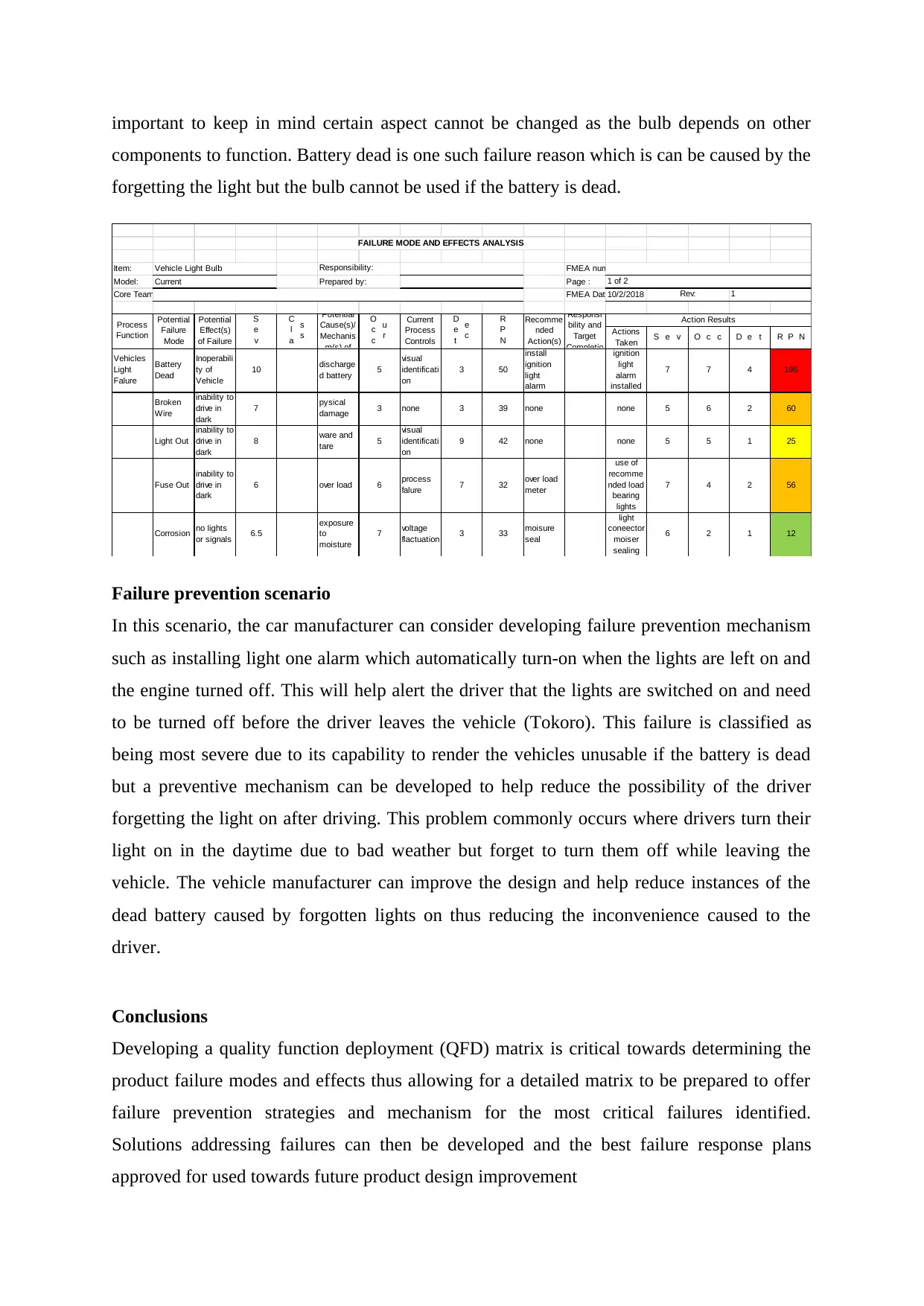
important to keep in mind certain aspect cannot be changed as the bulb depends on other
components to function. Battery dead is one such failure reason which is can be caused by the
forgetting the light but the bulb cannot be used if the battery is dead.
Item: FMEA number:
Model: Page :
Core Team: FMEA Date (Orig):10/2/2018
Actions
Taken S e v O c c D e t R P N
Vehicles
Light
Falure
Battery
Dead
Inoperabili
ty of
Vehicle
10 discharge
d battery 5
visual
identificati
on
3 50
install
ignition
light
alarm
ignition
light
alarm
installed
7 7 4 196
Broken
Wire
inability to
drive in
dark
7 pysical
damage 3 none 3 39 none none 5 6 2 60
Light Out
inability to
drive in
dark
8 ware and
tare 5
visual
identificati
on
9 42 none none 5 5 1 25
Fuse Out
inability to
drive in
dark
6 over load 6 process
falure 7 32 over load
meter
use of
recomme
nded load
bearing
lights
7 4 2 56
Corrosion no lights
or signals 6.5
exposure
to
moisture
7 voltage
flactuation 3 33 moisure
seal
light
coneector
moiser
sealing
6 2 1 12
Process
Function
Responsibility:
Prepared by:
Action Results
FAILURE MODE AND EFFECTS ANALYSIS
Potential
Failure
Mode
Potential
Effect(s)
of Failure
S
e
v
C
l
a
s
s
Potential
Cause(s)/
Mechanis
m(s) of
O
c
c
u
r
Current
Process
Controls
D
e
t
e
c
Recomme
nded
Action(s)
Responsi
bility and
Target
Completio
R
P
N
Vehicle Light Bulb
Current 1 of 2
Rev: 1
Failure prevention scenario
In this scenario, the car manufacturer can consider developing failure prevention mechanism
such as installing light one alarm which automatically turn-on when the lights are left on and
the engine turned off. This will help alert the driver that the lights are switched on and need
to be turned off before the driver leaves the vehicle (Tokoro). This failure is classified as
being most severe due to its capability to render the vehicles unusable if the battery is dead
but a preventive mechanism can be developed to help reduce the possibility of the driver
forgetting the light on after driving. This problem commonly occurs where drivers turn their
light on in the daytime due to bad weather but forget to turn them off while leaving the
vehicle. The vehicle manufacturer can improve the design and help reduce instances of the
dead battery caused by forgotten lights on thus reducing the inconvenience caused to the
driver.
Conclusions
Developing a quality function deployment (QFD) matrix is critical towards determining the
product failure modes and effects thus allowing for a detailed matrix to be prepared to offer
failure prevention strategies and mechanism for the most critical failures identified.
Solutions addressing failures can then be developed and the best failure response plans
approved for used towards future product design improvement
components to function. Battery dead is one such failure reason which is can be caused by the
forgetting the light but the bulb cannot be used if the battery is dead.
Item: FMEA number:
Model: Page :
Core Team: FMEA Date (Orig):10/2/2018
Actions
Taken S e v O c c D e t R P N
Vehicles
Light
Falure
Battery
Dead
Inoperabili
ty of
Vehicle
10 discharge
d battery 5
visual
identificati
on
3 50
install
ignition
light
alarm
ignition
light
alarm
installed
7 7 4 196
Broken
Wire
inability to
drive in
dark
7 pysical
damage 3 none 3 39 none none 5 6 2 60
Light Out
inability to
drive in
dark
8 ware and
tare 5
visual
identificati
on
9 42 none none 5 5 1 25
Fuse Out
inability to
drive in
dark
6 over load 6 process
falure 7 32 over load
meter
use of
recomme
nded load
bearing
lights
7 4 2 56
Corrosion no lights
or signals 6.5
exposure
to
moisture
7 voltage
flactuation 3 33 moisure
seal
light
coneector
moiser
sealing
6 2 1 12
Process
Function
Responsibility:
Prepared by:
Action Results
FAILURE MODE AND EFFECTS ANALYSIS
Potential
Failure
Mode
Potential
Effect(s)
of Failure
S
e
v
C
l
a
s
s
Potential
Cause(s)/
Mechanis
m(s) of
O
c
c
u
r
Current
Process
Controls
D
e
t
e
c
Recomme
nded
Action(s)
Responsi
bility and
Target
Completio
R
P
N
Vehicle Light Bulb
Current 1 of 2
Rev: 1
Failure prevention scenario
In this scenario, the car manufacturer can consider developing failure prevention mechanism
such as installing light one alarm which automatically turn-on when the lights are left on and
the engine turned off. This will help alert the driver that the lights are switched on and need
to be turned off before the driver leaves the vehicle (Tokoro). This failure is classified as
being most severe due to its capability to render the vehicles unusable if the battery is dead
but a preventive mechanism can be developed to help reduce the possibility of the driver
forgetting the light on after driving. This problem commonly occurs where drivers turn their
light on in the daytime due to bad weather but forget to turn them off while leaving the
vehicle. The vehicle manufacturer can improve the design and help reduce instances of the
dead battery caused by forgotten lights on thus reducing the inconvenience caused to the
driver.
Conclusions
Developing a quality function deployment (QFD) matrix is critical towards determining the
product failure modes and effects thus allowing for a detailed matrix to be prepared to offer
failure prevention strategies and mechanism for the most critical failures identified.
Solutions addressing failures can then be developed and the best failure response plans
approved for used towards future product design improvement
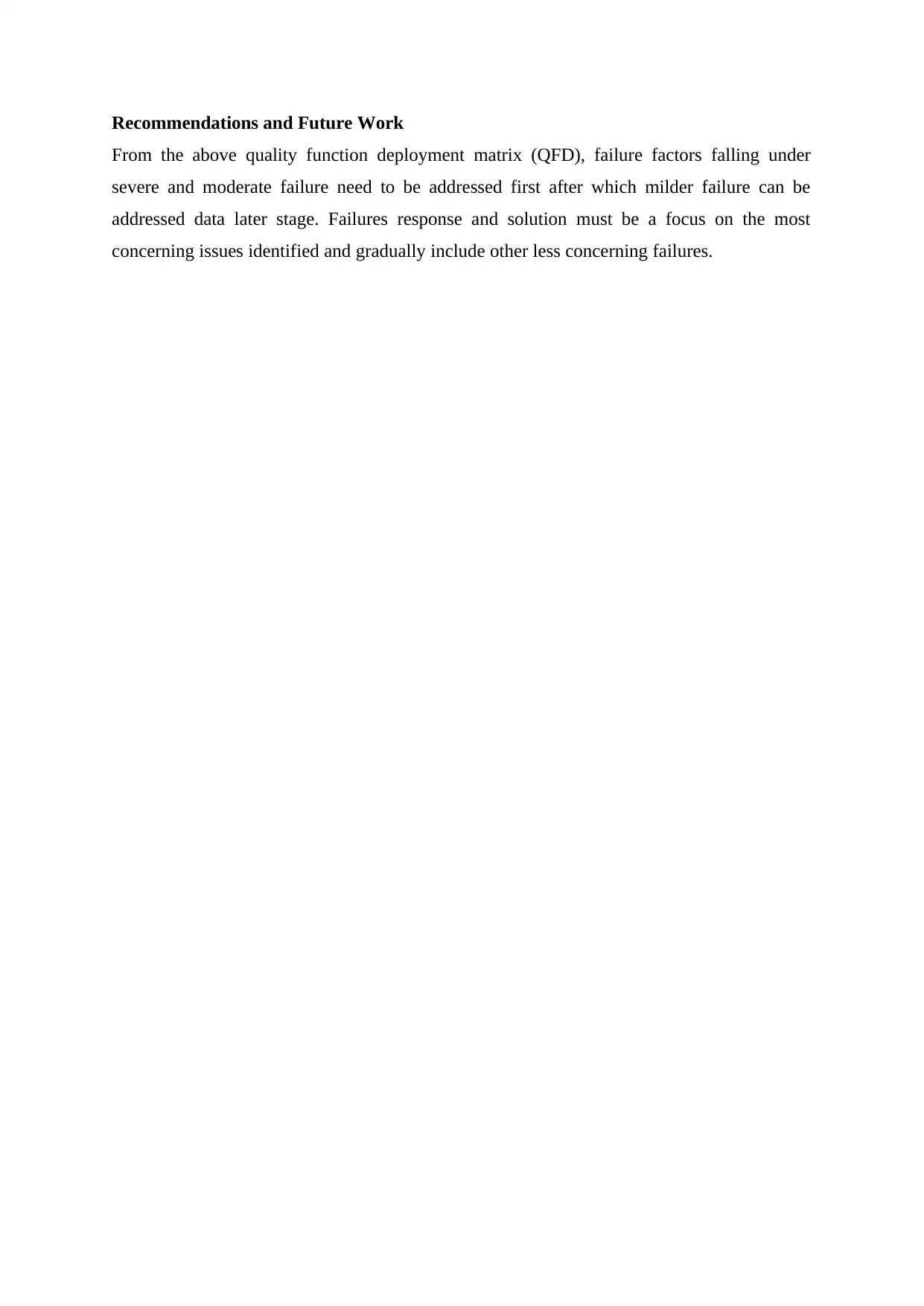
Recommendations and Future Work
From the above quality function deployment matrix (QFD), failure factors falling under
severe and moderate failure need to be addressed first after which milder failure can be
addressed data later stage. Failures response and solution must be a focus on the most
concerning issues identified and gradually include other less concerning failures.
From the above quality function deployment matrix (QFD), failure factors falling under
severe and moderate failure need to be addressed first after which milder failure can be
addressed data later stage. Failures response and solution must be a focus on the most
concerning issues identified and gradually include other less concerning failures.
Paraphrase This Document
Need a fresh take? Get an instant paraphrase of this document with our AI Paraphraser
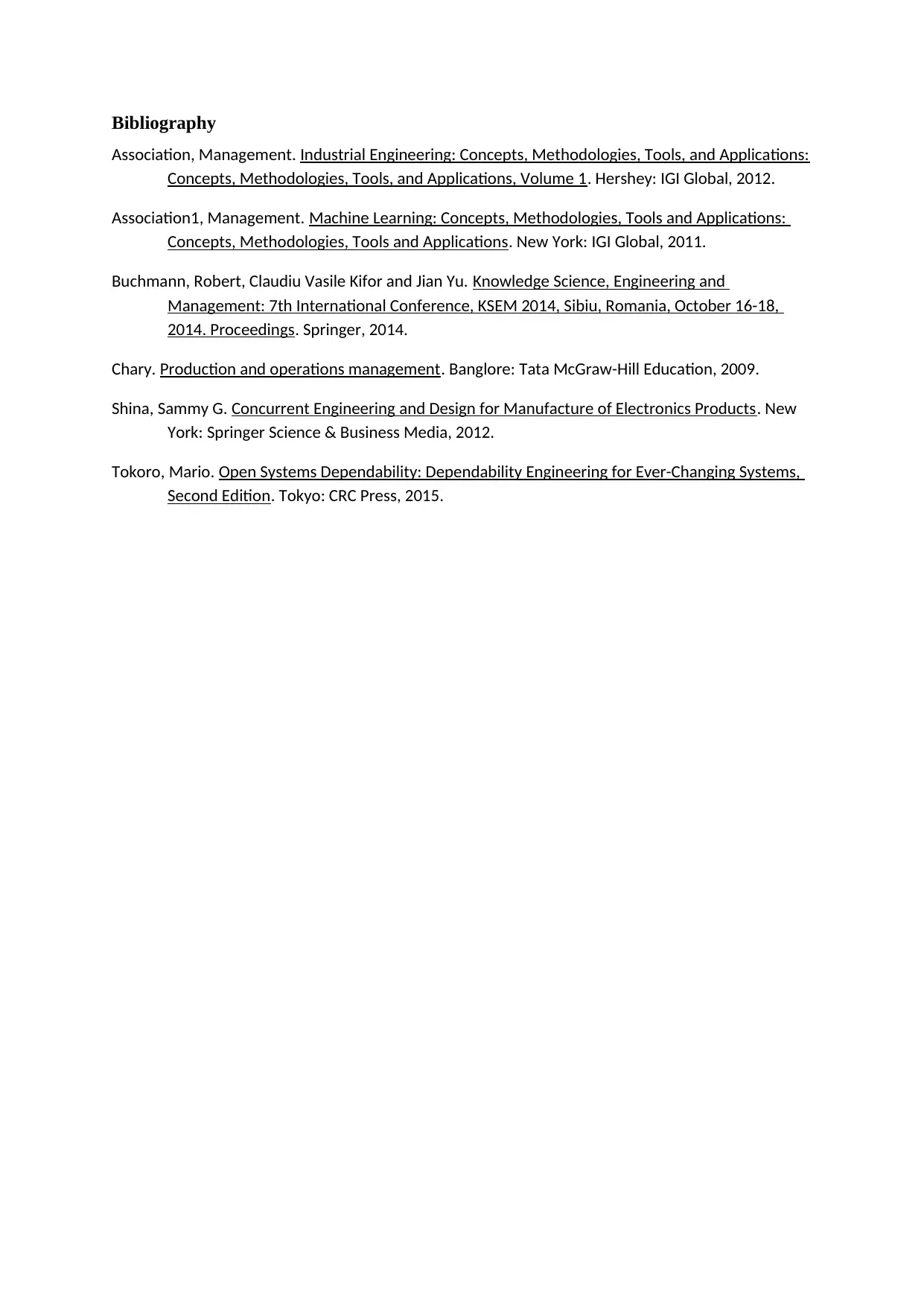
Bibliography
Association, Management. Industrial Engineering: Concepts, Methodologies, Tools, and Applications:
Concepts, Methodologies, Tools, and Applications, Volume 1. Hershey: IGI Global, 2012.
Association1, Management. Machine Learning: Concepts, Methodologies, Tools and Applications:
Concepts, Methodologies, Tools and Applications. New York: IGI Global, 2011.
Buchmann, Robert, Claudiu Vasile Kifor and Jian Yu. Knowledge Science, Engineering and
Management: 7th International Conference, KSEM 2014, Sibiu, Romania, October 16-18,
2014. Proceedings. Springer, 2014.
Chary. Production and operations management. Banglore: Tata McGraw-Hill Education, 2009.
Shina, Sammy G. Concurrent Engineering and Design for Manufacture of Electronics Products. New
York: Springer Science & Business Media, 2012.
Tokoro, Mario. Open Systems Dependability: Dependability Engineering for Ever-Changing Systems,
Second Edition. Tokyo: CRC Press, 2015.
Association, Management. Industrial Engineering: Concepts, Methodologies, Tools, and Applications:
Concepts, Methodologies, Tools, and Applications, Volume 1. Hershey: IGI Global, 2012.
Association1, Management. Machine Learning: Concepts, Methodologies, Tools and Applications:
Concepts, Methodologies, Tools and Applications. New York: IGI Global, 2011.
Buchmann, Robert, Claudiu Vasile Kifor and Jian Yu. Knowledge Science, Engineering and
Management: 7th International Conference, KSEM 2014, Sibiu, Romania, October 16-18,
2014. Proceedings. Springer, 2014.
Chary. Production and operations management. Banglore: Tata McGraw-Hill Education, 2009.
Shina, Sammy G. Concurrent Engineering and Design for Manufacture of Electronics Products. New
York: Springer Science & Business Media, 2012.
Tokoro, Mario. Open Systems Dependability: Dependability Engineering for Ever-Changing Systems,
Second Edition. Tokyo: CRC Press, 2015.
1 out of 8
Related Documents
Your All-in-One AI-Powered Toolkit for Academic Success.
+13062052269
info@desklib.com
Available 24*7 on WhatsApp / Email
![[object Object]](/_next/static/media/star-bottom.7253800d.svg)
Unlock your academic potential
© 2024 | Zucol Services PVT LTD | All rights reserved.





